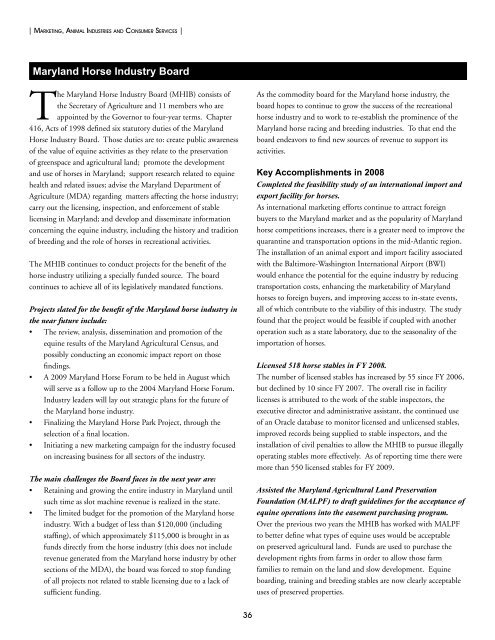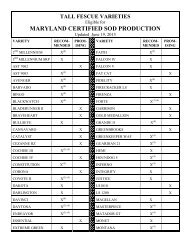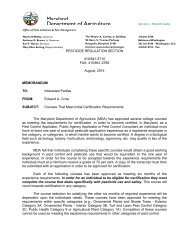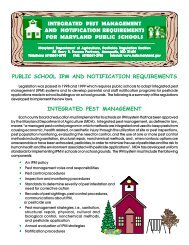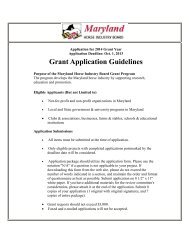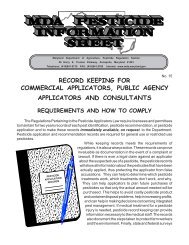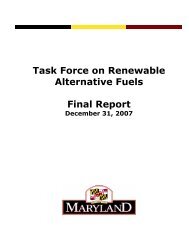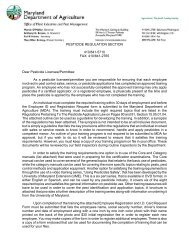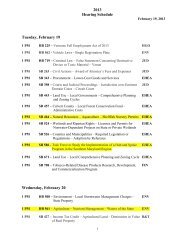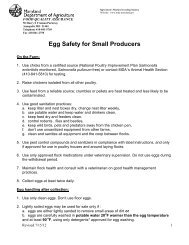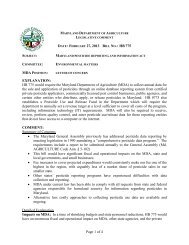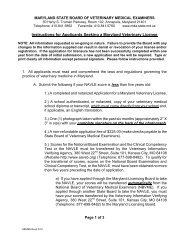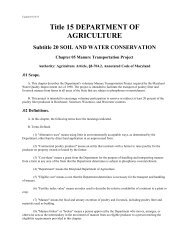2008 MDA Annual Report - Maryland Department of Agriculture
2008 MDA Annual Report - Maryland Department of Agriculture
2008 MDA Annual Report - Maryland Department of Agriculture
- No tags were found...
You also want an ePaper? Increase the reach of your titles
YUMPU automatically turns print PDFs into web optimized ePapers that Google loves.
| Ma r k e t i n g, An im a l In d u s t r i es a n d Co n s u m e r Services |<strong>Maryland</strong> Horse Industry BoardThe <strong>Maryland</strong> Horse Industry Board (MHIB) consists <strong>of</strong>the Secretary <strong>of</strong> <strong>Agriculture</strong> and 11 members who areappointed by the Governor to four-year terms. Chapter416, Acts <strong>of</strong> 1998 defined six statutory duties <strong>of</strong> the <strong>Maryland</strong>Horse Industry Board. Those duties are to: create public awareness<strong>of</strong> the value <strong>of</strong> equine activities as they relate to the preservation<strong>of</strong> greenspace and agricultural land; promote the developmentand use <strong>of</strong> horses in <strong>Maryland</strong>; support research related to equinehealth and related issues; advise the <strong>Maryland</strong> <strong>Department</strong> <strong>of</strong><strong>Agriculture</strong> (<strong>MDA</strong>) regarding matters affecting the horse industry;carry out the licensing, inspection, and enforcement <strong>of</strong> stablelicensing in <strong>Maryland</strong>; and develop and disseminate informationconcerning the equine industry, including the history and tradition<strong>of</strong> breeding and the role <strong>of</strong> horses in recreational activities.The MHIB continues to conduct projects for the benefit <strong>of</strong> thehorse industry utilizing a specially funded source. The boardcontinues to achieve all <strong>of</strong> its legislatively mandated functions.Projects slated for the benefit <strong>of</strong> the <strong>Maryland</strong> horse industry inthe near future include:• The review, analysis, dissemination and promotion <strong>of</strong> theequine results <strong>of</strong> the <strong>Maryland</strong> Agricultural Census, andpossibly conducting an economic impact report on thosefindings.• A 2009 <strong>Maryland</strong> Horse Forum to be held in August whichwill serve as a follow up to the 2004 <strong>Maryland</strong> Horse Forum.Industry leaders will lay out strategic plans for the future <strong>of</strong>the <strong>Maryland</strong> horse industry.• Finalizing the <strong>Maryland</strong> Horse Park Project, through theselection <strong>of</strong> a final location.• Initiating a new marketing campaign for the industry focusedon increasing business for all sectors <strong>of</strong> the industry.The main challenges the Board faces in the next year are:• Retaining and growing the entire industry in <strong>Maryland</strong> untilsuch time as slot machine revenue is realized in the state.• The limited budget for the promotion <strong>of</strong> the <strong>Maryland</strong> horseindustry. With a budget <strong>of</strong> less than $120,000 (includingstaffing), <strong>of</strong> which approximately $115,000 is brought in asfunds directly from the horse industry (this does not includerevenue generated from the <strong>Maryland</strong> horse industry by othersections <strong>of</strong> the <strong>MDA</strong>), the board was forced to stop funding<strong>of</strong> all projects not related to stable licensing due to a lack <strong>of</strong>sufficient funding.As the commodity board for the <strong>Maryland</strong> horse industry, theboard hopes to continue to grow the success <strong>of</strong> the recreationalhorse industry and to work to re-establish the prominence <strong>of</strong> the<strong>Maryland</strong> horse racing and breeding industries. To that end theboard endeavors to find new sources <strong>of</strong> revenue to support itsactivities.Key Accomplishments in <strong>2008</strong>Completed the feasibility study <strong>of</strong> an international import andexport facility for horses.As international marketing efforts continue to attract foreignbuyers to the <strong>Maryland</strong> market and as the popularity <strong>of</strong> <strong>Maryland</strong>horse competitions increases, there is a greater need to improve thequarantine and transportation options in the mid-Atlantic region.The installation <strong>of</strong> an animal export and import facility associatedwith the Baltimore-Washington International Airport (BWI)would enhance the potential for the equine industry by reducingtransportation costs, enhancing the marketability <strong>of</strong> <strong>Maryland</strong>horses to foreign buyers, and improving access to in-state events,all <strong>of</strong> which contribute to the viability <strong>of</strong> this industry. The studyfound that the project would be feasible if coupled with anotheroperation such as a state laboratory, due to the seasonality <strong>of</strong> theimportation <strong>of</strong> horses.Licensed 518 horse stables in FY <strong>2008</strong>.The number <strong>of</strong> licensed stables has increased by 55 since FY 2006,but declined by 10 since FY 2007. The overall rise in facilitylicenses is attributed to the work <strong>of</strong> the stable inspectors, theexecutive director and administrative assistant, the continued use<strong>of</strong> an Oracle database to monitor licensed and unlicensed stables,improved records being supplied to stable inspectors, and theinstallation <strong>of</strong> civil penalties to allow the MHIB to pursue illegallyoperating stables more effectively. As <strong>of</strong> reporting time there weremore than 550 licensed stables for FY 2009.Assisted the <strong>Maryland</strong> Agricultural Land PreservationFoundation (MALPF) to draft guidelines for the acceptance <strong>of</strong>equine operations into the easement purchasing program.Over the previous two years the MHIB has worked with MALPFto better define what types <strong>of</strong> equine uses would be acceptableon preserved agricultural land. Funds are used to purchase thedevelopment rights from farms in order to allow those farmfamilies to remain on the land and slow development. Equineboarding, training and breeding stables are now clearly acceptableuses <strong>of</strong> preserved properties.36


